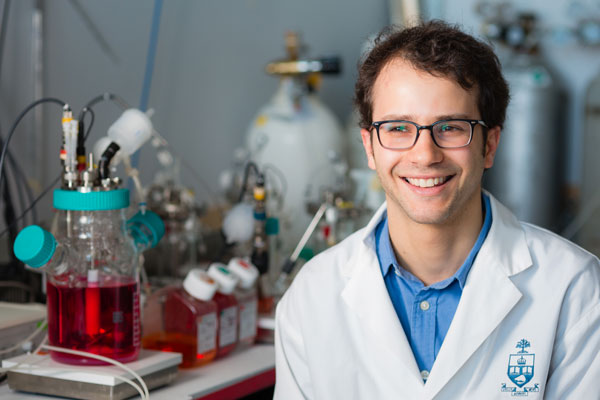Growing artificial human tissues and making automobiles don’t appear to have much in common, but a new paper suggests that some of the same engineering principles may apply.
Yonatan Lipsitz (BioMedE PhD Candidate) is the lead author on the new perspectives article published today in Nature Biotechnology. Along with his co-authors, Professor Peter Zandstra (IBBME) and Nick Timmins of the Centre for Commercialization of Regenerative Medicine (CCRM), Lipsitz has laid out a framework for how to develop the large-scale manufacturing processes needed to bring therapies based on stem cells — able to turn into different types of human cells — into the mainstream. At its heart is a principle adapted from the automotive and pharmaceutical industries: quality-by-design.
“It goes back to the 1950s, when engineers first realized that you can actually design the quality of a product into your process,” says Lipsitz, whose background is in chemical engineering. “It’s what brought the Japanese manufacturing industry to prominence in the 1970s, and today is applied to many diverse industries.”
If bioengineers are to realize their dream of using stem cells to grow replacements for bone marrow, heart or liver tissue, they will need to increase both the amount of cells they can produce, and the reliability with which they can produce them.
“For therapies treating heart disease, you’re looking at producing on the order of a billion cells per patient, with millions of patients each year,” says Lipsitz. “When you look at how people grow cells today in cell culture dishes, you can produce maybe one to ten million cells at a time. Scaling this production up by several orders of magnitude is a real challenge.”
The key, Lipsitz says, is understanding which properties of your product ensure its quality, and how those properties can vary. In the pharmaceutical industry, such properties include identity (i.e. molecular composition), potency (how well the drug works) and purity.
Adapting these properties for complex stem cell products can be tricky, since many cells look alike under a microscope, and it’s hard to know how they will behave in the body. But thanks to the emergence of new bioengineering, analytic, and systems biology tools, it’s starting to become easier to track and understand these characteristics, Lipsitz says.
“Our lab recently finished a project where we used a mathematical model to predict which factors would be important in blood stem cell manufacturing,” says Lipsitz. “For example, the model showed that a certain molecule produced by the cells would negatively affect cell growth. We were able to control the manufacturing process to keep the level of that molecule low enough to enable robust cell growth.” This finding is an important component of the new Canadian biotechnology start-up ExCellThera, a company focused on growing blood stem cells to treat leukemia.
Lipsitz and his collaborators don’t bother with petri dishes: their cells are grown in carefully-controlled vessels called bioreactors. “Biorectors are the industrial technology of choice for manufacturing cells and cell products, because they are scalable and controllable,” he says. “If I can manufacture in a 100-millilitre bioreactor, it’s not a huge leap to go from there to one litre or a hundred litres.”
Many more companies are poised to enter the stem cell-derived therapeutics space, but they face tough challenges. Some of the emerging treatments cost hundreds of thousands of dollars for a complete course of treatment. Lipsitz says that a lot of that cost comes down to inefficient manufacturing techniques. “If you can’t produce quality product every time, and you’re throwing away every third batch, your product will inevitably fail,” he says.
The hope is that by providing specific guidance on how to adapt quality-by-design principles to the nascent cellular therapeutics manufacturing industry, the new framework can ensure reliability, keep costs down, and help make the therapies more widely accessible. It also helps ensure that recent investments in stem cell-derived therapies — such as the $40 million in government and industry support provided to CCRM in January — have the greatest possible impact.
“Scientists know their biology, and they’re starting to gain an appreciation that robust manufacturing is needed,” says Lipsitz. “What we’ve done is proposed this manufacturing framework to ensure that the therapeutic products to come can be produced consistently, reliably, robustly, and cost-effectively.”




